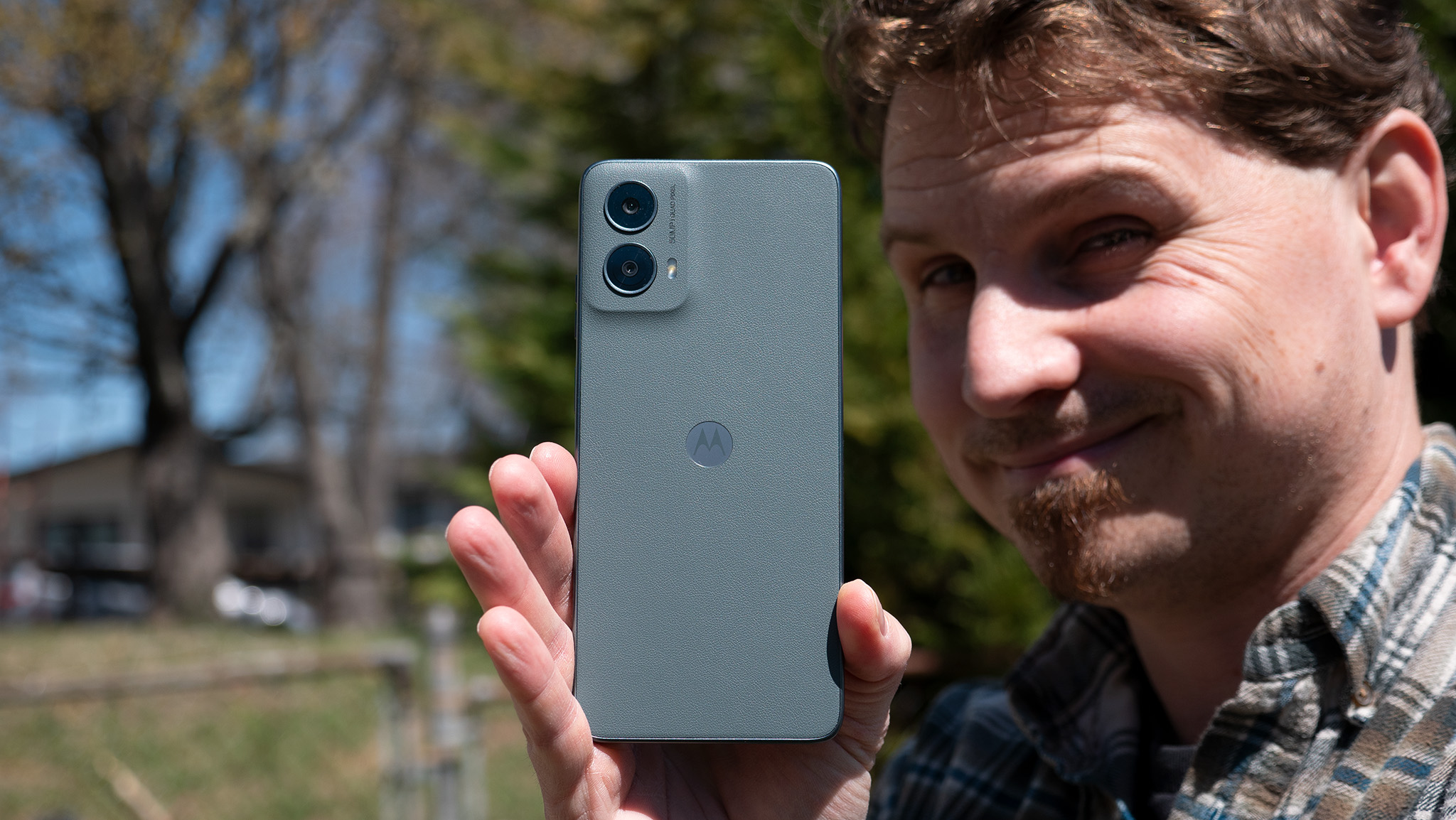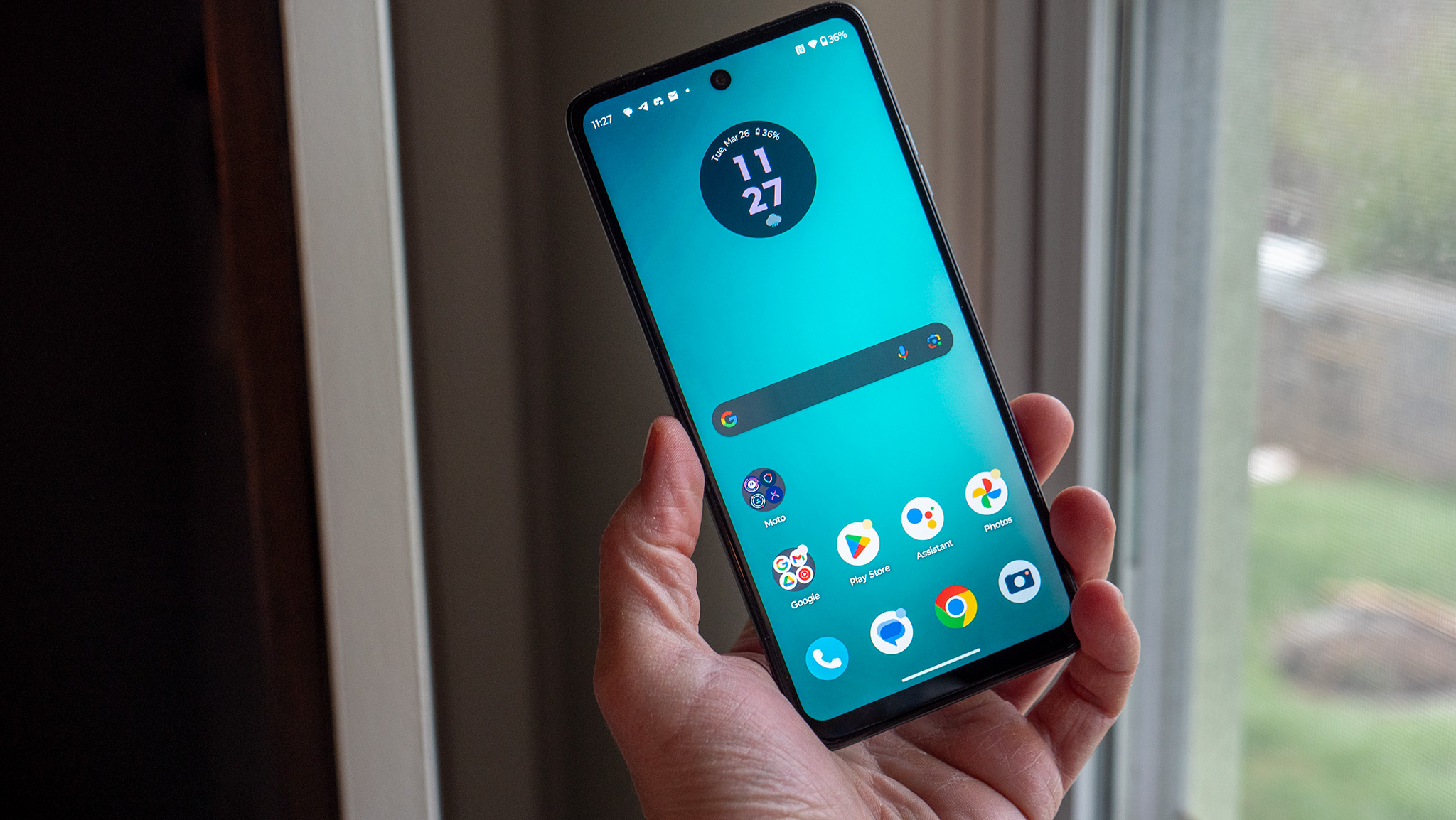Moto G 5G 2024 vs. Moto G 5G 2023: Should you upgrade?
Get a well-rounded Android smartphone for just around $200.

New and improved
Featuring a gorgeous vegan leather back panel, the Moto G 5G 2024 belies its modest price tag. The smartphone includes dual SIM support and 5G connectivity, and even has NFC for contactless payments.
Pros
- Stunning design with vegan leather back panel
- Eligible for Android 15
- NFC for contactless payments
Cons
- Still comes with 4GB of RAM
- Useless 2MP macro camera

Value for money
It may be old, but the Moto G 5G 2023 still has everything you could want in a budget Android phone. It includes 5G support, stereo speakers with Dolby Atmos, and much more, all at a price that's too good to resist.
Pros
- More affordable than ever
- All-day battery life
- Stereo speakers sound great
Cons
- Won't get any OS updates after Android 14
- No eSIM support
Motorola's Moto G series smartphones are (and have always been) renowned for offering incredible value for money, and the brand-new Moto G 5G 2024 is no different. From a minimal software experience to amazing battery life, the newest Motorola phone brings a lot to the table. It even includes some features that are usually found in much more expensive smartphones, while costing just a penny shy of $200.
As great as that price is, the previous-gen Moto G 5G 2023 — which is still available for purchase — can now be had for just under $150. So, the question is, should you go for the latest and greatest thing in town, or just get the previous-gen model and save even more of your money? Let's compare the Moto G 5G 2024 vs. Moto G 5G 2023 and find out.
Moto G 5G 2024 vs. Moto G 5G 2023: Design and display
Although the newer model is a tad heavier, both the Moto G 5G 2024 and Moto G 5G 2023 have a virtually identical physical footprint and overall design. The two also have an all-plastic frame, as well as similarly placed ports and buttons. However, the moment you flip over the two phones, the biggest visual difference between them immediately becomes apparent.

The Moto G 5G 2024 features a vegan leather back, which is a massive improvement over the plastic rear of the previous-gen model. Sure, vegan leather is technically a form of plastic, but it looks and feels much more premium, while also keeping away dust and fingerprints. As noted by Android Central's Nicholas Sutrich in his review, this design choice makes the Moto G 5G 2024 stand out in a sea of Android phones priced under $200, at least as far as looks are concerned.

The 6.6-inch display of the newer model is slightly larger than the 6.5-inch screen that you'd find on the Moto G 5G 2023, but that's the only difference between them. They are both IPS LCD panels (if you prefer the deep blacks and rich colors offered by AMOLED screens, we suggest checking out the Samsung Galaxy A15 5G) perfect for everyday use, and even though the display resolution is a little low (720p), you do get a 120Hz refresh rate for a better experience.
Moto G 5G 2024 vs. Moto G 5G 2023: Hardware and cameras
| Category | Moto G 5G 2024 | Moto G 5G 2023 |
|---|---|---|
| Dimensions | 164.3 x 74.9 x 8.2 mm | 163.9 x 74.9 x 8.3 mm |
| Weight | 194g | 189g |
| Durability & Material(s) | Water-repellent design, Vegan leather | Water-repellent design, PMMA |
| Display | 6.6-inch IPS LCD (720x1612 pixels resolution), 120Hz refresh rate | 6.5-inch IPS LCD (720x1600 pixels resolution), 120Hz refresh rate |
| Chipset / SoC | Qualcomm Snapdragon 4 Gen 1 | Qualcomm Snapdragon 480+ 5G |
| RAM & Storage | 4GB/128GB, with microSD expansion (up to 1TB) | 4GB/128GB, with microSD expansion (up to 1TB) |
| Sensors | Side-mounted fingerprint sensor, Proximity sensor, Ambient light sensor, Accelerometer, E-compass, Gyroscope, and Barometer | Side-mounted fingerprint sensor, Proximity sensor, Ambient light sensor, Accelerometer, E-compass, and Gyroscope |
| Connectivity | Wi-Fi 802.11ac, 5G, Bluetooth 5.1, NFC, GPS, and USB-C 2.0 | Wi-Fi 802.11ac, 5G, Bluetooth 5.1, GPS, and USB-C 2.0 |
| Other Features | Dual SIM, 3.5mm audio, and stereo speakers | Single SIM, 3.5mm audio, and stereo speakers |
| Battery & Charging | 5,000mAh, 18W wired charging | 5,000mAh, 15W wired charging |
| Cameras (Rear) | 50MP wide-angle, 2MP macro, 1080p video recording (30fps) | 48MP wide-angle, 2MP macro, 1080p video recording (30fps) |
| Camera (Front) | 8MP wide-angle, 1080p video recording (30fps) | 8MP wide-angle, 1080p video recording (30fps) |
| OS & Update Policy | Android 14 (preinstalled), one OS and three years of security updates | Android 13 (preinstalled), one OS and three years of security updates |
| Color Options | Sage Green | Ink Blue, Harbor Gray |
The Moto G 5G 2024 is powered by the Snapdragon 4 Gen 1, a newer and moderately better SoC than the Snapdragon 480+ 5G used by its predecessor. Disappointingly though, the RAM is still limited to 4GB. Although the chipsets are capable of handling daily-usage tasks like web browsing and light gaming, the paltry amount of RAM means you won't be able to multi-task or run resource-intensive apps particularly well on either of these phones. That said, both devices do come with 128GB of internal storage, along with support for microSD cards of up to 1TB.
Like its predecessor, the Moto G 5G 2024 packs in all the basics like Wi-Fi, multi-band 5G, stereo speakers, and a 3.5mm audio port. However, there's one extra addition that gives the newer model an edge over the Moto G 5G 2023, and that's NFC. Yep, you read that right! With the Moto G 5G 2024, you can make hassle-free contactless payments and leave your wallet at home.
Get the latest news from Android Central, your trusted companion in the world of Android

The Moto G 5G 2024 features a dual-lens rear camera setup with a 50MP primary sensor. In comparison, the Moto G 5G 2023 sports a 48MP primary sensor. The 50MP primary lens is the only one you should care about anyway because, like the last-gen model, the secondary sensor is a useless 2MP macro unit that doesn't do much.
The camera quality, as expected, is just about average, but you do get features such as dual capture, auto HDR, and more. Video recording is limited to 1080p (at 30fps), and the 8MP front-facing camera (same as that on the last-gen model) works well for selfies and video calls.
Moto G 5G 2024 vs. Moto G 5G 2023: Software and battery life
Budget phones usually don't offer much in terms of software support, and the same is true for the Moto G 5G 2024 and Moto G 5G 2023 as well, with both devices being eligible for just one major OS update and up to three years of security updates. That said, since the Moto G 5G 2024 is the newer phone, it already comes with Android 14 and will get Android 15 eventually. On the other hand, the Moto G 5G 2023 will stay on Android 14, since it launched with Android 13. If you like using your devices for a long time, this is definitely something worth taking into consideration.

The software itself is fairly stock-like, although it's spruced up with a diverse array of Motorola-exclusive improvements (e.g., quick gestures) that we've come to love over the past few years.
Just like the last-gen model, the Moto G 5G 2024 comes with a big 5,000mAh battery. However, the charging speed has gone up to 18W (in comparison, the Moto G 5G 2023 charges at 15W) for even faster top-ups. Combine that with the power-efficient hardware, and the phone should easily last you a full day with moderately heavy use.
Moto G 5G 2024 vs. Moto G 5G 2023: Should you upgrade?
With the Moto G 5G 2024, Motorola has hit yet another home run. It not only has all the essentials (e.g., 5G connectivity, awesome battery life), but also packs in goodies like NFC (for contactless payments via Google Wallet), while still costing less than what the Moto G 5G 2023 did at the time of its launch.
Speaking of the Moto G 5G 2023, the last-gen model can now be had for just $150, and that price is likely to drop even further during festive season sales. It's no doubt still a good phone, but is it really worth considering, now that the successor is here?

In our opinion, not really. The newer model comes with a much more premium design, NFC, faster wired charging, dual SIM (and eSIM) support, and an extra year of OS and security updates, all for just a few dollars more. So, unless you really need those extra savings and don't care about contactless payments, fancy rear panels, and things like that, getting the Moto G 5G 2023 makes little to no sense.

Thoughtful additions
The Moto G 5G 2024 improves upon the last-gen model by including useful features like NFC, dual SIM (with eSIM) support, and 18W fast charging. It runs the latest version of Android and will get three years of security updates.

All the essentials
The Moto G 5G 2023 may not have all the bells and whistles offered by its successor, but it gets the basics right. The phone packs a 120Hz display, stereo speakers, and a battery that can easily go a full day on a single charge.

When Rajat got his first Personal Computer—a Pentium III machine with 128MB of RAM and a 56kbps dial-up modem—back in 2001, he had little idea it would mark the beginning of a lifelong love affair with gadgets. That fascination, combined with a penchant for writing and editing, ultimately led to him becoming a technology journalist. Some of his other interests include Photography, Hand Lettering, and Digital Typography. Rajat is also somewhat obsessed with wrist-worn timepieces and appreciates a Casio just as much as a Jaeger-LeCoultre.
You must confirm your public display name before commenting
Please logout and then login again, you will then be prompted to enter your display name.
